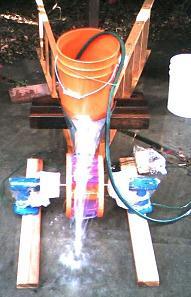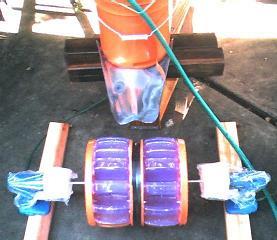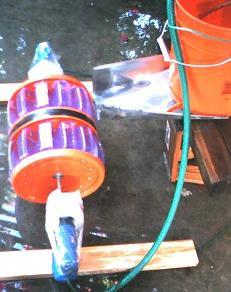
| |
 |
![]()
I measured output for one set of 12 cups in one water wheel driving two 14.4 volt cordless drills to be .3 to .7 amps (average .5 amps or .8 watt)
when charging one cell. I noticed it was barley able to overcome gear friction to start turning about half the time. Hose running in bucket by it's self is
not enough to cause rotation, but dumping in another 5 gallon bucket of water did cause rotation for a short time (about 15 sec). Drill generators were
taped into a clear plastic bag, to give water protection. Meter and battery were in a plastic bag with a tie wrap to seal it. Both generators were wired in
series.

I also tested a 1/8" water hose nozzle blasting water out at city water pressure (about 45 lbs/Sq. Inch). This approach would charge two cells at about
.45 amps and one cell at about .5 amp or .8 watt. This approach uses the inertia of the water. Both generators were wired in series. Next I tested
output for two sets or 24 cups making two water wheels driving two 14.4 volt cordless drills. I measured between .5 to 2.9 amps (or .8 to 5.2 watts)
charging one cell. Both generators were wired in series. I used about 20 gallons/minute flow rate for testing. My feeling is less would have also worked.
Trying to tune up the process when my tests only lasted 15 sec at a shot (one bucket full) was a bit of a challenge. I did see enough that I feel confident
that this unit will turn and generate electricity in a conscious stream of water situation.


Summary: My tests indicate one can charge a single cell at between .5 and 2.9 amps or about 1 to 5 watts. How long will the plastic gears and bushing
bearings last in continuous operation? This is anyone's guess. I think with regular maintenance of opening the gear box and lubricating that it may last for
a time. The theoretical maximum sustainable power one could get at drill rated speed of 550 RPM is about 45 watts from this series configuration.
Since this is running at well below rated speed and power it should help minimize maintenance. At about $10-$20 per generator one could stock up on
a few extras.
Power usage for a white LED is about 3.2 volts times .020 ma = .064 Watt. If one averages 4 watts generated 24 hrs/day this would result in 96
watt-hrs (4*24) of stored power. If one uses this over 4 hrs at night for tasks then the rate of usage would be 24 watt/hr (96/4). This would mean one
could light 375 (24/.064) white LEDs for the 4 hours or run a 100 watt ham radio unit for slightly less than one hour. In the long run this approach even
at a low power output should produce more stored power than by hand or by pedal bicycle power. Let water flow do the work for you. Wind power
is a possibly, however I tested a 16" propeller from a local hobby shop hooked to a 14.4 volt drill sticking out my car window at 70 miles per hour and
could not get it to start turning. I think a correct sized special high torque low speed propeller would need to be designed. Once done it could be
heavy, I am not sure the bearings would hold up for very long.
Offered by Mike.